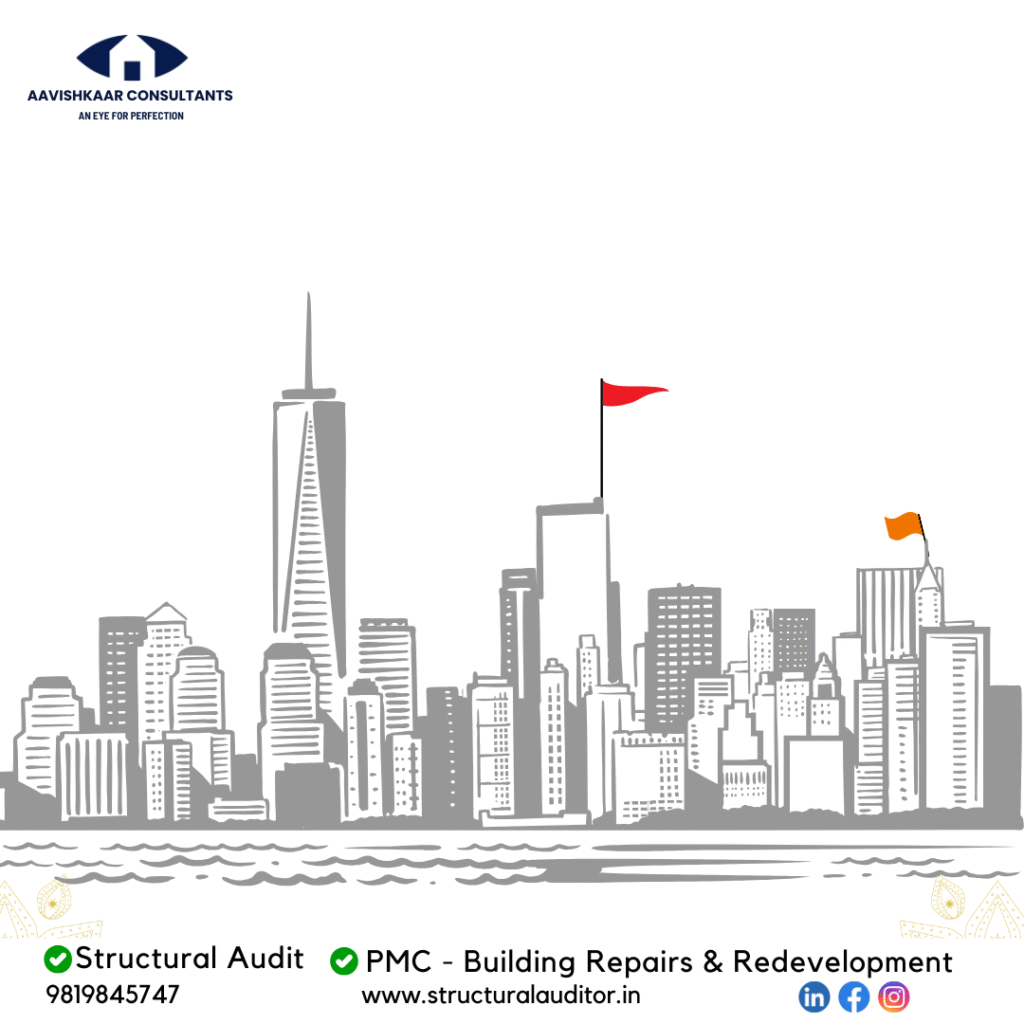Many housing societies face a critical choice after a structural audit—opt for builder-led redevelopment or take charge through self-redevelopment.
Both paths aim to improve safety and living conditions. But how they work, who controls the process, and the financial models differ significantly.
This guide breaks down both options, starting with why a structural audit is the foundation for any decision.
Why Structural Audits Are the First Step to Safer Redevelopment

A structural audit assesses a building’s health, stability, and future risks. It’s not optional—it’s essential for buildings over 30 years old or those showing signs of damage.
The audit identifies:
- Cracks in beams or columns
- Weak foundations
- Water seepage or corrosion
- Load-bearing failures
A certified audit helps housing societies understand:
- If the building can be repaired
- Whether partial strengthening is viable
- Or if the structure is unsafe and requires redevelopment
Aavishkaar Consultants conduct in-depth audits with clear, actionable reports. These findings are critical for making informed decisions and ensuring resident safety.
Without this step, redevelopment becomes a guesswork process—costly, risky, and often delayed. Housing societies must begin with a structural audit before approaching builders or planning self-redevelopment. It provides a solid technical foundation and peace of mind.
Redevelopment : How It Works and What to Expect
Key Advantages of Redevelopment
In builder-led redevelopment, a developer funds, designs, and executes the entire project. In return, they get rights to additional floors or flats to sell.
Benefits include:
- No direct cost to residents
- New amenities (elevators, parking, security, fire systems)
- Additional carpet area or compensation
- Quick project execution (usually within 2–3 years)
It’s a turnkey solution. Builders bring their expertise, finance, and management teams. Housing societies benefit from modern buildings without upfront investments.
This option is ideal for societies without the capital, technical knowledge, or time to manage a project themselves.
Limitations and Risks of Redevelopment
However, builder-led redevelopment has limitations:
- Loss of control: The builder decides project features, material quality, and timelines.
- Delays and disputes: If a builder backs out or faces financial issues, residents suffer.
- Hidden clauses: Contracts must be reviewed carefully to avoid future complications.
- Quality concerns: Without independent checks, construction quality may suffer.
A weak or unclear Development Agreement can lead to long-term legal and financial challenges.
Thus, while convenient, redevelopment requires careful selection of a builder and solid legal agreements.
What Is Self-Redevelopment and How It Differs
Self-redevelopment empowers housing societies to rebuild their property without a builder.
Societies form a management team, appoint consultants, architects, and contractors, and take control of planning, funding, and execution.
This model has gained popularity after policy support from state governments and easier access to funding via co-operative banks.
Benefits of Self-Redevelopment
Key benefits include:
- Full control: Society decides everything from layout to contractor choice.
- Higher returns: Profits from selling extra flats go back to the society.
- Better quality: Direct oversight ensures transparency and material quality.
- Government schemes: Access to MHADA or DCPR incentives, subsidies, and FSI benefits.
Societies that are well-organized and have good financial discipline can gain long-term returns from self-redevelopment.
Challenges of Self-Redevelopment
Self-redevelopment isn’t for everyone. Challenges include:
- Project management: Requires technical, legal, and financial knowledge
- Upfront costs: While loans are available, initial expenses can be high
- Time and effort: Society members must be actively involved
- Execution risk: Delays due to mismanagement or inexperience
Professional guidance is essential. Many societies appoint PMC firms or consultants like Aavishkaar to manage the complexities while retaining decision-making power.
How Aavishkaar Consultants Support Your Redevelopment Decision
Whether a society opts for redevelopment or self-redevelopment, Aavishkaar Consultants provide comprehensive support:
- Structural audits to assess safety and feasibility
- Feasibility reports for both redevelopment models
- Project Management Consultancy (PMC) for execution oversight
- Liaison with architects, contractors, and legal teams
- Help in getting approvals from municipal bodies and financial institutions
Aavishkaar brings over 15+ years of experience in structural audits, building repairs, and redevelopment planning.
They help societies make informed decisions, reduce risks, and ensure projects stay on time and within budget.
Final Thoughts: Choosing the Right Path for Your Society
No one-size-fits-all solution exists. Your decision depends on:
- The structural health of your building
- Financial strength of your society
- Willingness to manage a project
- Trust in external developers
Begin with a structural audit. It sets the stage for everything that follows.
Whether you choose builder-led redevelopment or self-redevelopment, make sure you work with experienced professionals like Aavishkaar Consultants to ensure a smooth, transparent, and successful transformation.
Structural Audit: Real Insight into a Building’s Health Report
When we talk about the longevity and safety of a building, one of the most…
Redevelopment vs Self-Redevelopment After Structural Audit: What Housing Societies Must Know
Many housing societies face a critical choice after a structural audit—opt for builder-led redevelopment or…
Why Core Test NDT Testing is Important in Structural Audit
Structural audits are critical to determine the health and durability of a building.Among various techniques…
Half Cell Potential Test – A Key Method in Structural Audits
Structural audits assess a building’s safety and durability. Corrosion in reinforced concrete can weaken structures…
Understanding Ultrasonic Testing NDT: Uses and Key Details
Ultrasonic Testing Non-destructive testing (NDT) is essential for assessing the integrity of materials without causing…
Structural Audit – What Happens If We Do Not Conduct a Structural Audit of Our Building?
Why Structural Audit Are Crucial for Building Safety Structural audit play a pivotal role in…

